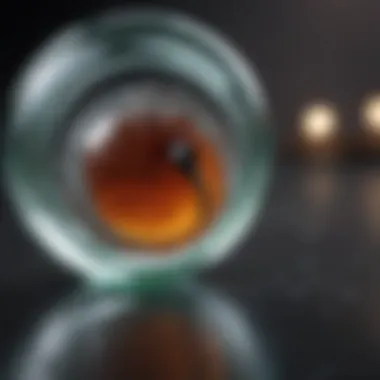The Glass Recycling Process Explained in Detail


Overview of the Topic
The glass recycling process represents a critical aspect of modern waste management and environmental sustainability. Recycling glass is not only an efficient way to manage waste but also significantly reduces the consumption of raw materials and energy. As the world increasingly recognizes the importance of sustainable practices, understanding the intricacies of the glass recycling process becomes essential. This knowledge is pertinent for conservationalists, students, and environmentalists alike.
Glass is 100% recyclable, meaning it can be melted down and remanufactured into new glass products without losing quality. This characteristic inherently supports sustainable resource management and conservation efforts, making the examination of the glass recycling process vital.
Current Status and Challenges
Despite the positive aspects of glass recycling, the current state presents both opportunities and challenges.
Current State
Globally, recycling rates for glass vary widely. In countries like Germany, recycling rates reach over 90%, while in others, rates are significantly lower. Lack of facilities necessary for processing and collection infrastructure tends to hinder progress in less developed areas. Additionally, there is a growing demand for manufactured glass products which can strain existing resources.
Identified Challenges
One of the primary challenges facing glass recycling is contamination. When glass containers are mixed with non-recyclable materials, it can compromise the entire batch. Moreover, public awareness regarding which materials are recyclable plays a crucial factor. Inconsistent recycling programs across regions add to the confusion, leaving many unsure of their role in recycling efforts.
Sustainable Solutions
Addressing the challenges of glass recycling requires innovative practices and community engagement.
Sustainable Practices
Local governments and organizations can implement robust educational campaigns. These efforts can raise awareness about proper recycling habits, ultimately reducing contamination rates. Furthermore, investments in improved sorting facilities can enhance efficiency in processing recycled materials.
Successful Case Studies
Countries with high recycling rates, such as Sweden and South Korea, showcase effective resource management practices. They have established comprehensive collection systems and public outreach initiatives that have increased participation in recycling programs. Learning from these models can provide a pathway for improving glass recycling rates globally.
Impact and Importance
The implications of successful glass recycling extend beyond environmental benefits.
Impact on Ecosystems and Communities
By reducing the need for new raw materials, glass recycling diminishes the ecological footprint associated with manufacturing. Additionally, communities that invest in recycling programs not only create jobs but also foster a culture of sustainability.
Importance of Conservation Efforts
Conserving resources is paramount for ensuring future generations can meet their needs without depleting the planet's resources. Glass recycling plays a pivotal role in achieving this goal, promoting responsible consumption and waste management.
"Recycling glass saves energy and resources, and reinforces a sustainable cycle essential for preserving the environment."
Prelude to Glass Recycling
The glass recycling process plays a pivotal role in sustainable resource management. Understanding how glass is collected, processed, and reused can greatly enhance efforts toward environmental conservation. This section breaks down the crucial elements, benefits, and considerations surrounding glass recycling.
Definition of Glass Recycling
Glass recycling refers to the process of collecting used glass materials and converting them into reusable raw materials. Unlike many materials, glass can be recycled indefinitely without losing quality, making it a unique resource. The cycle begins with collection, where glass items like bottles and jars are gathered either through curbside pickup or recycling centers. After collection, the glass undergoes sorting and cleaning to remove impurities. This step is essential to ensure the viability of the resulting recycled glass, known as cullet, which is then used to produce new glass products.
Significance in Environmental Conservation
The importance of glass recycling cannot be overstated in the context of environmental conservation. By choosing to recycle glass, communities can significantly reduce landfill waste. According to some estimates, every ton of recycled glass can prevent about a ton of raw materials from being mined and processed. This reduction in raw material extraction conserves natural resources, leading to lower energy consumption and reduced greenhouse gas emissions.
Moreover, recycling glass contributes to a circular economy, where materials are reused rather than discarded. This transition not only enhances sustainability but also supports economic growth through job creation in recycling industries. The more glass that is recycled, the less pressure is placed on ecosystems and the environment.


"Recycling one glass bottle saves enough energy to light a 100-watt bulb for four hours."
Whether viewed from a waste management perspective or an energy conservation angle, the role of glass recycling in protecting the environment is clear. As we delve deeper into the glass recycling process, the need for effective recycling systems and consumer awareness becomes apparent. More education and engagement are vital for maximizing the benefits of glass recycling.
The Lifecycle of Glass
The lifecycle of glass is essential in understanding how this material can be effectively recycled and reused. Each stage, from the sourcing of raw materials to the ultimate disposal or recycling options, plays a crucial role in ensuring that glass remains a sustainable resource. By comprehensively examining the lifecycle, we gain insights into how glass recycling not only conserves resources but also reduces environmental impact. This understanding is particularly important for conservationists and environmentalists who aim to promote sustainable practices.
Raw Materials and Production
The production of glass begins with the extraction of raw materials. The primary components of glass are silica sand, soda ash, and limestone. These materials are carefully selected for their purity and quality. Silica sand, which provides the glass's primary structure, is abundant, but its mining has to be managed sustainably to avoid land degradation. Soda ash, derived from natural deposits or through chemical processes, acts as a flux to lower the melting point of silica, enabling easier formation.
During production, these raw materials are heated in a furnace at very high temperatures, often exceeding 1,700 degrees Celsius. This process is energy-intensive and can lead to significant carbon emissions. Hence, recycling glass is vital, as it reduces the need for new raw materials and energy consumption associated with glass production. Moreover, recycled glass, known as cullet, melts at a lower temperature, which enhances energy efficiency in the melting process.
In addition, using cullet in production minimizes waste. It can be reused multiple times without degrading its quality, making it an ideal raw material for manufacturing new glass products. Incorporating recycled materials not only conserves natural resources but also improves the circular economy of glass manufacturing.
Use and Disposal
After production, glass products are used in various applications, from containers to construction materials. The durability of glass is one of its most significant advantages; it can last indefinitely without loss of quality. This characteristic promotes extended use and encourages recycling at the end of its life.
However, the disposal of glass poses its challenges. Many consumers place glass in regular waste instead of recycling bins, leading to increased landfill volume. According to estimates, glass accounts for about 40% of urban solid waste. Recycling efforts hinge on consumer awareness and participation, making education essential in promoting responsible disposal practices.
When glass is disposed of improperly, it can break down into shards that create hazards in landfills. However, when recycled correctly, glass can be processed and returned to the supply chain. It's essential for consumers to engage actively in proper disposal methods, as their efforts directly impact recycling success rates.
"Recycling glass not only saves raw materials and energy but also diverts waste from landfills, making it critical for environmental sustainability."
Ultimately, a thorough understanding of the lifecycle of glass — from raw material extraction through production, use, and disposal — underlines the importance of recycling in facilitating sustainability strategies. This comprehensive approach ensures that glass can be continuously reused, forming a closed-loop system that minimizes waste and conserves vital resources.
Collection Process
The glass collection process forms a critical cornerstone in the overall recycling framework. Its efficiency significantly influences the success of glass recycling efforts, impacting not only environmental sustainability but also economic feasibility. By effectively collecting glass materials, the industry ensures a steady supply of raw materials for recycling facilities. This section will explore the various collection systems available today as well as the importance of consumer engagement in maximizing glass recovery rates.
Types of Collection Systems
Collection systems can be broadly categorized into two main types: curbside collection and drop-off centers. Each has its unique advantages and strategies that adapt to different communities and regions.
- Curbside Collection: This method involves collecting recyclables directly from households. Residents place their glass along with other recyclables at the curb for pick-up. This system tends to have higher participation rates as it offers convenience to consumers. However, it requires robust logistical planning to manage the vehicles and routes effectively.
- Drop-off Centers: In this system, consumers must transport their recyclables to designated locations. These centers may be set up in various places such as supermarkets, community centers, or dedicated recycling facilities. While drop-off centers can reduce costs related to collection logistics, they may face challenges with lower participation and convenience for consumers.
Each collection system can be effective when implemented correctly, often depending on local infrastructure and community habits. Understanding the strengths and weaknesses of these systems helps in developing strategies that enhance overall recovery rates.
Consumer Participation and Awareness
Consumer participation plays a pivotal role in the glass recycling process. It signifies the level of support from the community and directly affects the volume of glass collected for recycling.
- Education and Awareness: Active awareness campaigns can significantly impact consumer behavior. Informing individuals about the benefits of glass recycling, along with clear instructions on how to participate, can foster a more proactive approach. Utilizing social media platforms like Facebook or community forums on Reddit can help strengthen awareness initiatives.
- Incentive Programs: Some regions have introduced incentive programs where consumers receive rewards for recycling efforts. Such initiatives can enhance participation rates, making recycling a more engaging community activity.
- Feedback Mechanisms: Implementing feedback systems can help gauge consumer satisfaction with the collection process. Communities can share their experiences or suggest improvements, which can lead to better service and higher engagement in future recycling efforts.
In summary, the collection process is undeniably vital to glass recycling. Effective systems encourage participation and cooperation from the public, while ongoing education fosters an environment of collective responsibility towards sustainability. As awareness grows, so will the availability of glass for recycling, ultimately benefiting the environment and the economy.
Sorting and Cleaning
Sorting and cleaning are pivotal stages in the glass recycling process. These steps determine the quality and viability of recycled glass, known as cullet. Proper sorting separates different types and colors of glass, which is essential for effective recycling. Cleaner cullet enhances the melting phase and ultimately results in superior quality glass products. The process encompasses several important elements, benefits, and considerations.
Manual vs. Automated Sorting Methods
Manual sorting involves workers inspecting and separating glass by type and color. This method benefits from human judgment but can be slow and labor-intensive. It allows for fine-tuning, as workers can identify contaminants and impurities that machines may overlook. Despite this, the method can lead to inconsistencies in sorting accuracy.
On the other hand, automated sorting uses advanced technology, such as infrared sensors and air jets, to identify and sort glass. Automated systems increase efficiency and can process large volumes of glass quickly. However, the initial installation costs can be high, and technical malfunctions can result in mistakes. A blended approach can be beneficial, utilizing the strengths of both manual and automated methods.


Importance of Contamination Control
Contamination control holds significant importance in the sorting and cleaning stage. Foreign materials, such as plastic, metal, or ceramic, can severely degrade the quality of cullet. Therefore, maintaining a clean glass stream is essential for effective recycling. Contaminants can lead to increased operational costs during the melting process and result in inferior glass products.
To minimize contamination, education and awareness campaigns for consumers are necessary. Encouraging proper disposal methods reduces the likelihood of contaminants entering the recycling stream. Moreover, regularly reviewing sorting practices can help facilities adapt to new challenges and technologies.
"Quality cullet is the foundation of successful glass recycling and influences the entire lifecycle of glass products."
Crushing and Cullet Production
Crushing and cullet production form a critical phase in the glass recycling process. This stage serves several purposes that are vital for efficient recycling. Cullet is the term used for crushed recycled glass. It reduces energy consumption, contributes to overall material efficiency, and supports the glass manufacturing industry by providing a sustainable raw material.
Crushing Techniques
The process of crushing involves breaking down collected glass into smaller pieces. This is typically done using industrial crushers which can handle various sizes and types of glass. There are several techniques employed:
- Impact Crushing: This method uses high-speed rotors to impact the glass, effectively breaking it into smaller shards.
- Compression Crushing: Here, the glass is subjected to high pressure until it fractures.
- Shear Crushing: This involves applying shearing forces that split the glass shards apart.
Each of these techniques has distinct advantages. Impact crushing is fast and effective for large volumes, while compression crushing offers greater control over the size of the cullet, ensuring uniformity which is crucial for the glass manufacturing process.
Cullet as a Raw Material
Cullet serves as a significant raw material in glass production. It has several benefits, making it invaluable:
- Energy Savings: Using cullet in the melting process reduces the amount of energy required compared to using raw materials alone.
- Lower Greenhouse Gas Emissions: By using cullet, manufacturers lower their carbon footprint. This reduction can be significant when recycled glass replaces a substantial portion of raw materials.
- Enhanced Glass Quality: Cullet typically contains fewer impurities than raw materials, leading to a higher quality end product.
In summary, crushing and cullet production are essential components in the glass recycling process that provide numerous environmental and economic benefits. Recyclers and manufacturers alike depend heavily on these processes to promote sustainability and efficiency.
"Cullet reduces the environmental impact of glass production and promotes a circular economy by reusing materials."
Through proper implementation of various crushing techniques and utilizing cullet effectively, the glass recycling process becomes a model for sustainable production and resource management.
Melting and Forming
The melting and forming stage in the glass recycling process is critical. This phase determines how well the cullet can be transformed back into usable glass products. When recycled glass is melted, it can be reformed into a diverse array of new containers or products. Thus, this process plays a significant role in minimizing environmental impact while maximizing resource efficiency.
Melting Process Overview
The melting process starts with gathering cullet, which is the crushed recycled glass. This cullet is mixed with raw materials such as sand, soda ash, and limestone. The mixture is heated in a furnace typically operating at temperatures exceeding 1,400 degrees Celsius.
Once the glass reaches the melting point, it becomes a molten liquid. From this stage, it can be shaped and poured into molds to form new products. The benefits of using cullet during the melting process include:
- Energy savings: Melting cullet requires less energy than melting raw materials alone due to its lower melting temperature.
- Reduced emissions: Utilizing recycled glass diminishes greenhouse gas output, contributing positively to environmental health.
- Resource conservation: This method decreases the need for virgin materials, ensuring more sustainable usage of natural resources.
Moreover, melting cullet reduces the volume of waste sent to landfills, further enhancing its environmental benefits.
Subsequent Forming Techniques
Once the glass is in a molten state, forming techniques come into play. There are several methods employed to create new products from the melted glass. These methods include:
- Blowing: Often used in manufacturing bottles and jars; the molten glass is inflated using air to create hollow shapes.
- Pressing: Common for manufacturing glassware; the molten glass is pressed into molds to achieve desired forms.
- Casting: This technique involves pouring molten glass into a mold to create flat pieces or art glass.
- Fiber Forming: Involves drawing glass fibers from molten glass, often used for insulation materials.
These forming techniques are essential as they not only determine the quality of the final product but also influence the efficiency of the glass recycling operation. By refining and innovating these techniques, the glass recycling industry continues to evolve, offering better solutions for product design and sustainability.
"The use of recycled glass in the manufacturing process is crucial for both economic and environmental reasons."
Recycling Challenges


Recycling challenges present significant obstacles in the glass recycling industry. Understanding these challenges is crucial for conservationists, students, and environmentalists who seek to improve sustainable practices. This section delves into two main areas: Economic Barriers and Technical Limitations. Both aspects contribute to the overall efficiency of glass recycling and have far-reaching implications for environmental conservation.
Economic Barriers
Economic barriers play a significant role in the effectiveness of glass recycling programs. They often stem from the financial realities that waste management companies, municipalities, and consumers face. The cost of transporting glass to recycling facilities can outweigh potential economic benefits. For many local governments, it becomes more cost-efficient to dispose of glass in landfills rather than invest in recycling processes.
Market fluctuations also impact glass recycling. The demand for recycled glass can vary, leading to fluctuations in the market value of cullet. When prices drop, counters to glass recycling may find it hard to justify the operational costs. Furthermore, the advent of cheaper, non-recyclable alternatives has led consumers to prioritize cost over sustainability.
Another challenge is the insufficient funding for recycling facilities. Many recycling plants require significant investment in technology and infrastructure to improve their processes. Without these developments, recycling efforts may struggle to keep pace with increasing consumer waste.
"A strong economic framework is essential to support effective recycling systems, ensuring the environmental benefits are realized."
Technical Limitations
Technical limitations are another critical challenge in glass recycling. The technology available today, while advanced, still encounters hurdles that reduce efficiency in processing and recycling glass. One major issue is the diversity of glass types. Different glass compositions, such as those from bottles versus windows, affect how they can be recycled together. If these types are mixed, it makes the recycling process more complex and costly.
Quality control also poses challenges in glass recycling. Contaminants, such as food residues or other non-glass materials, can compromise the quality of recycled glass. This contamination often requires additional cleaning processes, thereby increasing operational costs.
Furthermore, existing recycling technologies may not utilize energy-efficient methods. While there are improvements, energy consumption in melting and forming new glass still presents a significant concern. Reducing energy use not only cuts costs but also minimizes environmental impact.
Technological Innovations in Glass Recycling
Technological innovations play a pivotal role in advancing glass recycling. They enhance efficiency, reduce costs, and improve overall environmental impact. As the demand for sustainable practices increases, the adoption of new technologies has become essential. This section explores how these innovations are revolutionizing the glass recycling landscape.
Advancements in Sorting Technologies
One significant area of innovation is in sorting technologies. Automated sorting systems utilize advanced sensors and artificial intelligence to accurately separate glass by color and type. This precision is crucial because it leads to higher quality cullet. Higher-quality cullet yields better glass products when remelted.
Modern sorting facilities often employ near-infrared sensors. These devices identify different glass types that the human eye may miss. Moreover, the integration of advanced robotics further accelerates the sorting process, reducing labor costs and increasing throughput. This technology minimizes contamination risks, which is vital since even small amounts of impurities can affect the final product's quality.
In addition to these automated solutions, machine learning algorithms are employed to optimize sorting operations. By analyzing data from sorting systems, these algorithms can continually improve performance. The overall efficiency gained through these advancements has the potential to significantly lower operational costs.
"Innovations in sorting can increase glass recycling rates by up to 30%, leading to more sustainable practices within the industry."
Energy Efficiency Improvements
Energy efficiency is another critical focus in glass recycling technology. Older recycling processes were often energy-intensive and not environmentally friendly. However, recent improvements in energy efficiency have reduced the carbon footprint associated with glass recycling.
For example, modern furnaces that melt cullet operate at higher efficiencies. They can melt cullet at lower temperatures compared to virgin materials. This reduction in energy consumption has a direct impact on greenhouse gas emissions. By using cullet, the melting point is lower, which means less energy is required to produce new glass.
Additionally, some glass recycling facilities are exploring renewable energy sources to power their operations. By integrating solar panels or wind turbines, they can further reduce their reliance on fossil fuels. This shift not only decreases operational costs but also enhances the sustainability profile of the entire glass recycling process.
The benefits of increased energy efficiency extend beyond mere cost savings. Less energy consumption directly correlates with lower emissions. This connection is essential for meeting global sustainability goals and reducing the climate impact associated with glass production.
In summary, technological innovations in the glass recycling process are not just beneficial; they are essential for future sustainability. Through advancements in sorting technologies and energy efficiency improvements, the glass recycling industry can contribute significantly to conserving resources and protecting the environment.
End
In this examination of the glass recycling process, it is essential to recognize the overall significance of the conclusion. This final section brings together the various elements discussed throughout this article, emphasizing the interconnectedness of every stage in the recycling process. Understanding the complexity of glass recycling not only informs readers about its technical aspects but also highlights its vital role in environmental sustainability.
The conclusion synthesizes the critical points discussed, reminding us of the challenges and innovations within the industry. Recycling glass conserves natural resources and reduces energy consumption. These factors contribute to achieving more sustainable practices within our industries and communities.
Summary of Key Points
- Importance of Glass Recycling: Glass recycling is crucial for reducing waste and conserving resources. It minimizes the amount of glass sent to landfills, reducing environmental impact.
- Lifecycle Considerations: The lifecycle of glass involves several stages, from raw material acquisition to the eventual disposal of the product. Each step presents opportunities for improvement in sustainability.
- Collection and Sorting: Efficient collection systems and thorough sorting processes ensure high-quality recycling outputs. These processes are vital for producing clean cullet, which is essential for new glass production.
- Technological Innovations: Recent advancements in technology are enhancing sorting methods and improving energy efficiency in the glass recycling sector, paving the way for more effective recycling practices.
- Future Prospects: The ongoing evolution in glass recycling, influenced by technological progress and industry demand, suggests the potential for developing more efficient systems and processes.
Future Directions for Glass Recycling
The future of glass recycling hinges on continued innovation and collaboration within the industry. The following aspects should be considered to advance this important field:
- Enhanced Sorting Technologies: Implementing more sophisticated and automated sorting technologies can significantly increase recycling rates by reducing contamination.
- Public Awareness Campaigns: Increasing consumer awareness about the importance of glass recycling is crucial. Educational initiatives can drive higher participation rates in recycling programs, leading to better outcomes.
- Closing the Loop: Efforts should be directed at creating a circular economy for glass, ensuring that glass products are reused and recycled continuously rather than disposed of.
- Policy Development: Governments and industry bodies should establish policies that encourage innovation and investment in glass recycling infrastructure.
- Global Collaboration: Countries can learn from each other and share successful practices in glass recycling, strengthening global efforts towards sustainability.
Communities, industries, and governments need to work together to address these future challenges, maximizing the benefits of glass recycling in resource management and environmental conservation.



